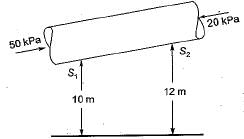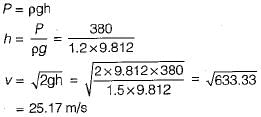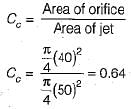Test: Dynamic of Fluid Flow - 3 - Mechanical Engineering MCQ
10 Questions MCQ Test Fluid Mechanics for Mechanical Engineering - Test: Dynamic of Fluid Flow - 3
The Bernoulli’s equation refers to conservation of
How are the velocity coefficient Cv, the discharge coefficient Cd and the contraction coefficient Cc of an orifice related
The coefficient of velocity (Cv) for an orifice is
The equation of motion for a viscous fluid known as
A smooth pipe of diameter 200 mm carries water. The pressure in the pipe at section S1 (elevation:10 m) is 50 kPa. At section S2 (elevation:12 m) the pressure is 20 kPa and velocity is 2 ms-1. Density of water is 1000 kgm-3 and acceleration due to gravity is 9.8 ms-2. Which of the following is TRUE
While measuring the velocity of air ρ = 1.2 kg/m3, the difference in the stagnation and static pressure of a Pitot-static tube was found to be 380 Pa. The velocity at that location in m/s is
If a fluid jet discharging from a 50 mm diameter orifice has a 40 mm diameter at its vena contracta, then its coefficient of contraction will be
Match List-I with List-il and select the correct answer using the codes given below the lists:
List-I
A. Orifice meter
B. Broad crested weir
C. Pitot tube
D. Rotameter
List-Il
1. Measurement of flow in a channel
2. Measurement of velocity in a pipe/channel
3. Measurement of flow in a pipe of any inclination
4. Measurement of upward flow in a vertical pipe
Codes:
A B C D
(a) 3 1 4 2
(b) 1 3 2 4
(c) 3 1 2 4
(d) 1 3 4 2
A Pitot tube is used to measure the velocity of water in a pipe. The stagnation pressure head is 6 m and the static pressure head is 5 m. If the coefficient of tube is 0.98, then what is the velocity of flow?
|
56 videos|106 docs|75 tests
|























